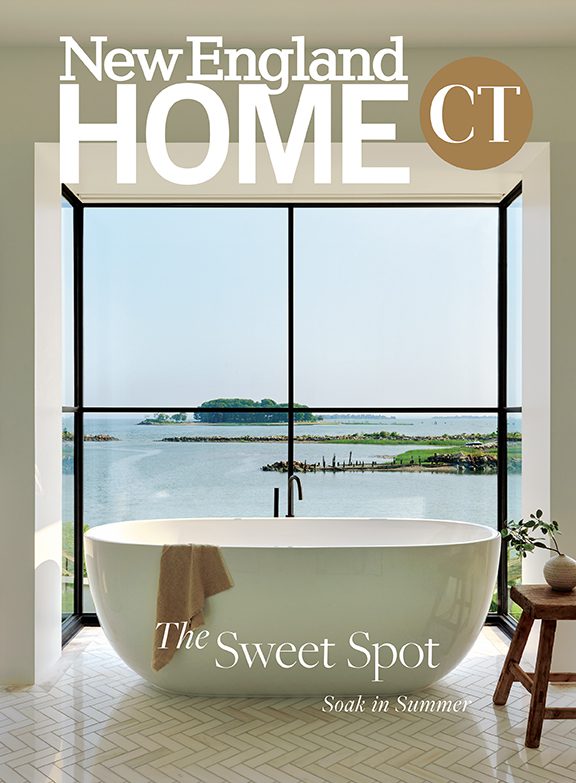Natural Inclinations
May 1, 2012
Text by Louis Postel Photography by Courtesy of Paul Bowen
At mid-career, Paul Bowen has built up a considerable fan base. His admirers like everything about him: the Welsh accent, the spark in his eye, the grin preceding a self-effacing pause and, most of all, the stubborn love he devotes to his art. He has spent decades gathering, choosing, recycling, sawing, gluing and nailing choice bits of wood and debris for his sculptures, and countless hours fishing for squid to collect its ink for his drawings.
The fruit of his labors may look like a Celtic shield, a fishhook, a dragon’s eye, a flailing arm, a distant trawler. Whatever the resemblance, it’s undeniably a Bowen. There’s a certain uncompromising quality that makes his work unique, edgy and challenging. Architects Tom Huth and Ted Danzer have a number of Bowen’s bold statements in their Provincetown vacation home. “His work is very strong. We had to design the living room around the sculptures, not the other way around,” says Huth.
The department store Nordstrom has recently joined Huth and Danzer as a Bowen collector. Shoppers at the store’s Braintree, Massachusetts, location are welcomed by Drift Stack, in which a driftwood shaft steers a moon-like circle through invisible waves: a kind of rhapsodic dream. If a high-end department store seems an unlikely place for a sculpture created from bits and pieces of salvaged wood, Bowen has selected and put together those scraps as meticulously as the finest couturier.
Unlike this year’s fashion statement, however, Bowen’s concerns are timeless. “There’s no whimsy with Paul’s work,” says Hartford, Connecticut, art dealer Kevin Garvey Rita. “While it may appear haphazard, nothing he does is accidental. It’s about making deep connections.”
His drawings of draggers disappearing in the mist, for instance, seem to carry us back to a distant time, trying to reclaim the unclaimable. They are more about fading connections than about fishing boats. Knowing that the vessels’ blue-blackness comes from squid ink Bowen collected himself somehow makes them even more poignant, like a message in a bottle cast into the sea by a survivor.
Certainly Bowen enjoyed his share of success before Nordstrom came calling. His work can be found in the collections of the Guggenheim in New York, the deCordova Sculpture Park in Lincoln, Massachusetts, the Cape Cod Museum of Art in Dennis and the Fogg Museum at Harvard University.
Bowen was born in 1951 and grew up in the Victorian seaside resort of Colwyn Bay in North Wales. “It was a landscape shaped by the human hand for thousands of years,” he says. He recalls exploring ancient burial chambers and castles on family outings. His father, an architect, introduced him to the art of finding elegant solutions to complex structural problems. “Working with constraints is what I do,” the son says today. “I try not to waste a thing. Say I needed a wedge of wood and I had it here, but it was painted red. Indeed, I could sand it off, but then a red piece I might need later on would be wasted. So I’ve got to keep looking.”
A 1977 fellowship at the Fine Arts Work Center brought him to another seaside resort—Provincetown—where he stayed for almost thirty years. Seven years ago, while he was the artist in residence at Dartmouth College, he and his wife, Pamela Mandell, bought a house close by a covered bridge in Williamstown, Vermont. Bowen set up one of his two studios in a backyard sugar shack. When Hurricane Irene blew by last year, she delivered huge amounts of debris along the riverbanks by Bowen’s property. Edited and sorted, some of that stockpile is destined to become works of art. “Some even stuck way up in the trees,” he recalls. “Now I probably won’t have to gather stuff for the rest of my life.”
On a late-winter day, brave crocuses and snowdrops lead the way to the studio Bowen uses for his larger projects, a space on the second floor of a barn not far from his home. He inspects what appears to be a very ordinary piece of wood. “I’m looking to make things that are visually dynamic,” he says. “This could be a kind of flying wedge, quasi-static but at the same time pushing off some plane or surface.”
Whether the ensuing piece ends up at a mall or a museum, have no fear it will be an uncompromising work: impeccably elegant, deeply serious.
Editor’s Note: To see more of Paul Bowen’s work, visit www.paulbowen.org.
Share
![NEH-Logo_Black[1] NEH-Logo_Black[1]](https://b2915716.smushcdn.com/2915716/wp-content/uploads/2022/08/NEH-Logo_Black1-300x162.jpg?lossy=1&strip=1&webp=1)












You must be logged in to post a comment.